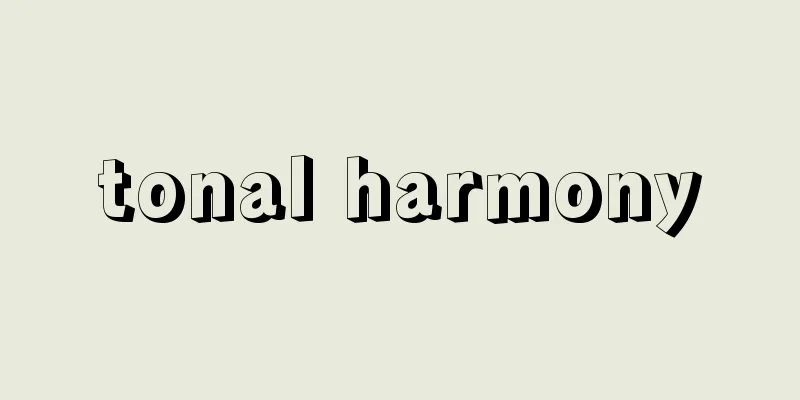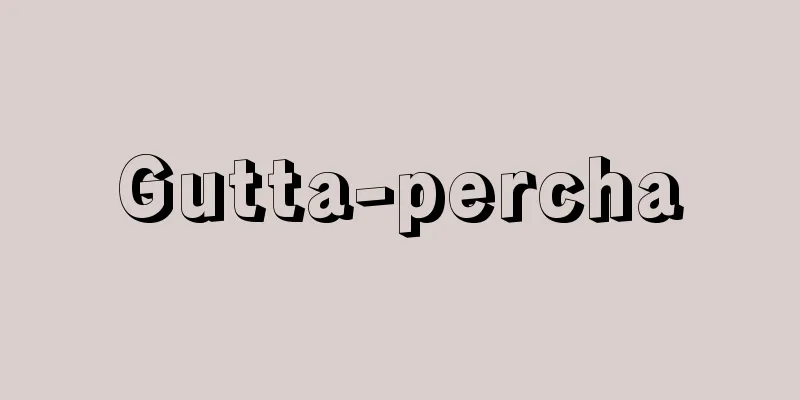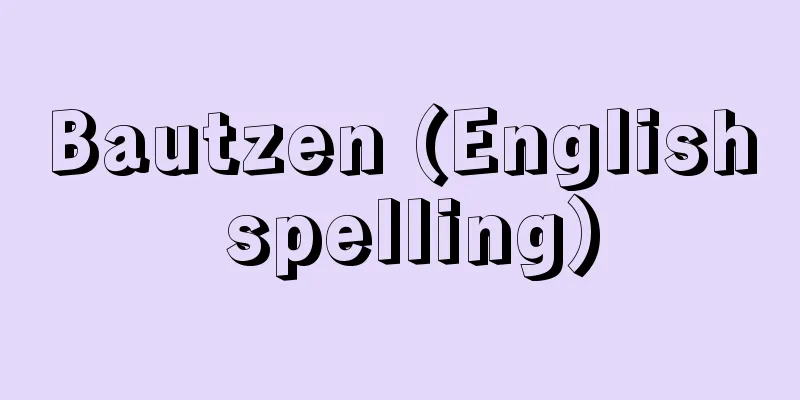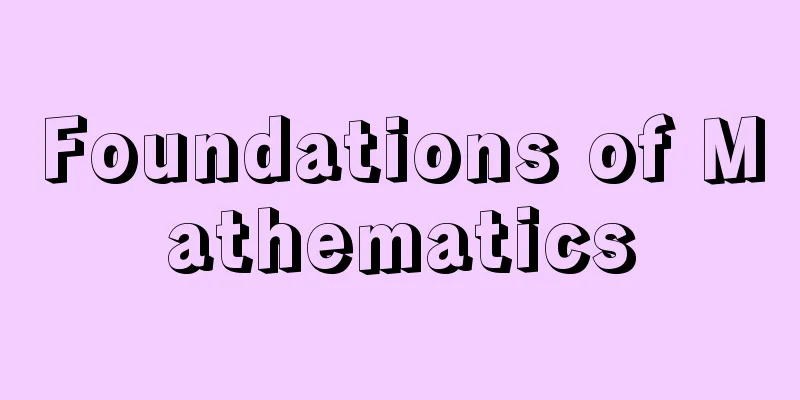Heart

|
The heart is the organ that drives blood circulation in humans and animals, and acts as a pump by alternately contracting and expanding to send blood to every corner of the body. [Kazuyo Shimai] Human heart morphologyThe human heart is a hollow organ with a thick wall made mainly of myocardium (striated muscle). The heart is located in the thoracic cavity in the lower anterior part between the left and right lungs (this space is called the thoracic mediastinum), and is in front of the anterior chest wall and behind the esophagus. The long axis of the heart runs diagonally from the upper right rear to the lower left front, but two-thirds of the heart as a whole is located to the left of the midline. The shape of the heart is like a peach, with the wide part at the top being the base of the heart, through which the large arteries and veins enter and exit. The lower end of the heart faces the left front and protrudes in a cone shape called the apex of the heart. Each time the heart beats, the apex of the heart hits the anterior chest wall at the fifth intercostal space on the left side of the anterior chest wall, about four finger widths (8 to 9 centimeters) away from the midline of the sternum, so the beating can be felt from the surface of the body. The anterior and superior surface of the heart is called the sternocostal surface because it contacts the inner surface of the sternum and ribs, and the inferior and posterior surface is called the phrenic surface because it contacts the diaphragm. The left and right surfaces of the heart are called the pulmonary surfaces. The size of the heart is said to be about the size of a person's fist, but in the case of Japanese adults, the weight is about 250 to 270 grams (according to Shigeru Sano). The weight of the heart increases with age, and by gender, men are slightly heavier than women. The right half of the heart receives blood from the entire body and sends it to the lungs, while the left half receives fresh blood from the lungs and sends it to the entire body. There is a coronary groove running horizontally slightly above the anterior surface of the heart, and the atria occupy the upper third of the interior, coinciding with the position of this groove, and the ventricles occupy the lower two-thirds. The upper atria are divided into the left and right atria by the atrial septum, and the lower ventricles are divided into the left and right ventricles by the ventricular septum. The atrial septum and ventricular septum are continuous, and most of the septum is muscular, with some parts being membranous. [Kazuyo Shimai] Cardiac Muscle StructureMost of the thickness of the heart wall is myocardium, and looking at the structure of this myocardium, the atrium is characterized by two layers of muscle (inner layer, outer layer), while the ventricle is characterized by three layers of muscle (outer layer, middle layer, inner layer). There is no connection between the atrial muscle and the ventricular muscle, and the border between them is a ring-shaped annulus fibrosus (corresponding to the coronary sulcus) that divides the atrium and ventricle into upper and lower parts. The outer layer of the atrial muscle surrounds the left and right atria together and runs horizontally, while the inner layer arises from the annulus fibrosus, surrounds the left and right atria separately in a ring shape, runs obliquely and horizontally, and then attaches again to the annulus fibrosus. The atrial muscle is thinner and less developed than the ventricular muscle. The outer layer of the ventricular muscle starts from the annulus fibrosus in the upper right corner, runs along the anterior surface of the right ventricle toward the lower right front, reaches the apex, where it rotates in a spiral shape to form a cardiac vortex, and then moves to the inner layer. The inner layer ascends obliquely along the left ventricular wall and attaches to the annulus fibrosus. The middle layer runs almost horizontally, surrounding the left and right ventricles separately. The force of ventricular contraction is mainly due to the force of this middle layer of muscle. The inner wall of the atrium, especially the inner surface of the anterior part of the right atrium, has parallel comb-like protrusions. These are raised muscle fiber bundles and are called pectinate muscles. The inner surface of the left atrium is mostly smooth. The inner wall of the ventricle has a net-like protrusion of muscle fiber bundles called trabeculae. Some of the trabeculae protrude like papillae and are called papillary muscles. There are three papillary muscles in the right ventricle and two large papillary muscles in the left ventricle. The inner surface of the heart is the endocardium, which is made up of a single layer of endothelial cells and a small amount of connective tissue, and is in contact with the blood. [Kazuyo Shimai] Heart, arteries and veinsThe right atrium has a cavity called the sinus caval, into which the superior and inferior vena cava drain. The entrance from the right atrium to the right ventricle is called the right atrioventricular orifice, which contains the triangular right atrioventricular valve (tricuspid valve). The tips of the tricuspid valve are connected to three papillary muscles and fibrous cords called chordae tendineae, which pull the cusp valve toward the ventricle. The pulmonary artery orifice to the pulmonary artery is located at the anterior upper part of the right ventricle. Four pulmonary vein orifices open into the posterior wall of the left atrium. The left atrioventricular orifice, which is the entrance to the left ventricle, is located at the anterior lower part of the left atrium, which contains the left atrioventricular valve (bicuspid valve or mitral valve). The bicuspid valve is connected by two papillary muscles and chordae tendineae. The opening to the aorta is located at the upper right corner of the left ventricle. The pulmonary artery orifice from the right ventricle and the aortic orifice from the left ventricle each have three semilunar valves. Both the cusp valves and the semilunar valves are folds formed by the inner membrane, which prevent the backflow of blood. [Kazuyo Shimai] The nervous system of the heartThe heart is distributed from the outside by the sympathetic and parasympathetic nerves (vagus nerves), which regulate the activity of the heart. When the sympathetic nerves are excited, the heart rate increases and the contractile force becomes stronger, making the heart more active (promoting), while when the parasympathetic nerves are excited, the heart rate decreases and the contractile force becomes weaker (inhibitory). In this way, the two nerves work in harmony to maintain efficient cardiac function while performing opposing actions (called antagonism). The heart is also distributed by sensory nerves. The contractile activity of the heart, that is, the pumping action, is performed by the conduction system within the heart. Under appropriate conditions, as long as this conduction system is active, the heart will automatically continue to contract rhythmically, even if the control of the autonomic nerves (sympathetic and parasympathetic nerves) is cut off. This is the role of the heart as a pacemaker. This conduction system is made up of special cardiac muscle fibers. These are the sinoatrial node (Keith-Flack node) located near the inner surface of the right atrial wall, the atrioventricular node (Tahara node) in the posterior wall of the right atrium, and the atrioventricular bundle (bundle of His) extending from this atrioventricular node. Excitation of the sinoatrial node causes contraction of the entire atrium, which stimulates the atrioventricular node, and this excitation passes through the atrioventricular bundle and is transmitted to the ventricles, causing ventricular contraction. The atrioventricular bundle from the atrioventricular node descends within the interatrial septum, penetrating the annulus fibrosus and reaching the interventricular septum, where it branches into two, and both branch bundles descend under the left and right ventricular endocardium to become Purkinje fibers and reach the base of the papillary muscles. [Kazuyo Shimai] Epicardium and feeding arteriesThe connective tissue that directly surrounds the heart is called the epicardium, which turns around at the roots of the large blood vessels leaving the heart and then moves to the outside, where it again surrounds the heart as the pericardium. This creates an internal cavity between the epicardium and the pericardium, which contains a small amount of pericardial fluid (serous fluid). The heart is further surrounded on the outside by a thick connective tissue membrane, which is connected to the posterior surface of the sternum by ligaments. The left and right coronary arteries, which supply blood to the heart, run through the coronary groove on the anterior surface of the heart, but these arteries, which supply blood to the myocardium, have few anastomoses, so when the blood vessels become narrower due to arteriosclerosis or other reasons and blood flow decreases, the blood supply from the anastomosed branches is insufficient, and myocardial tissue is prone to degeneration. This degeneration is called myocardial infarction. The same condition can also be caused by blood clots due to arteriosclerosis. The heart undergoes complex changes during development, and various factors can cause malformations, making it susceptible to congenital heart disease. Of these, the most common is patent foramen ovale. This disease occurs when the foramen ovale, which opens in the atrial septum during fetal development, does not close after birth (the left and right atria are normally completely separated) and remains open. This disease is more common in women than men, and oxygen-poor blood from the right atrium is sent to the left atrium where it mixes with fresh blood, causing various circulatory disorders. [Kazuyo Shimai] Blood CirculationBlood plays an important role as a transporter, supplying oxygen and nutrients to all tissues and organs, receiving waste products and carbon dioxide produced as a result of the activity of each tissue, and delivering these unnecessary substances to the organs that process them (kidneys and lungs). The driving force that creates the flow of this blood (blood flow) and enables it to perform its transport work effectively is the heart. If the flow of blood circulating throughout the body and transporting various substances is likened to a railway, the heart can be said to be a power plant that supplies energy so that each train can run at a moderate speed. Just as all trains stop when a power plant breaks down, blood flow stops when the heart stops, and as a result, all tissues in the body become oxygen-deficient, leading to rapid death (brain death occurs three minutes after cardiac arrest). The blood circulation is divided into the small circulation (pulmonary circulation) and the large circulation (systemic circulation). The small circulation is a circuit for taking in oxygen and releasing carbon dioxide in the lungs, and blood flows in the following order: right atrium → right ventricle → pulmonary artery → pulmonary capillaries → pulmonary vein → left atrium. The right side of the heart (right cardiac system), i.e., the right atrium and right ventricle, are involved in this small circulation. The right ventricle is the driving force behind this blood flow in the small circulation, and there is a tricuspid valve between the right atrium and right ventricle, and a pulmonary valve at the exit from the right ventricle to the pulmonary artery to prevent blood from flowing backwards. On the other hand, the left side of the heart (left cardiac system) is involved in the general circulation, and blood flows from the left atrium to the left ventricle to the aorta to the artery to the capillaries throughout the body to the veins to the vena cava to the right atrium, supplying oxygen and nutrients to tissues throughout the body. In the general circulation, the left ventricle acts as a pump, and blood is forcefully ejected into the aorta by the contraction of the left ventricle. It takes only 7 to 9 seconds for blood to be ejected from the left ventricle, pass through the general circulation and the minor circulation, and then return to the left ventricle. [Hidenobu Mashima] Heart rateAt rest, the heart contracts and expands 70 to 80 times per minute to pump blood, and the number of times the heart beats per minute is called the heart rate. The beating of the heart can be palpated on the left anterior chest. The beating of the heart also causes vibrations in the arterial walls, which can be palpated as the pulse in the neck (internal carotid artery) and wrist (radial artery). Therefore, the heart rate and pulse rate usually match. The resting heart rate varies from person to person, as well as by age and sex. The heart rate, which is 100 to 140 in infancy, decreases as we grow, to 70 to 80 in young adults and 60 to 70 in the elderly. Also, girls generally have a higher heart rate than boys. The amount of blood pumped out by the ventricles with one contraction is called the "stroke output," and for an adult at rest, this is about 60 milliliters on average. The amount of blood pumped out from the ventricles in one minute is called the "cardiac output per minute," which can be calculated by multiplying the stroke output by the heart rate. The cardiac output per minute for an adult at rest is 4 to 7 liters. If we assume that the heart beats 70 times per minute, then over a 70-year period, the heart beats approximately 2.6 billion times. If we assume that the stroke volume is 60 milliliters, then over the same 70-year period, the heart will pump out approximately 150 million liters of blood. This is a truly astonishing feat for an organ that weighs just under 300 grams. [Hidenobu Mashima] Blood flow and pressureThe heart pumps an appropriate amount of blood into the arteries in this way, but there are various resistances that impede blood flow as the blood travels from the arteries through the capillaries and veins distributed throughout the body before returning to the heart. For this reason, high pressure must be applied when the blood is initially pumped into the aorta. If the pressure in the left ventricle cavity is measured using an appropriate device, it is found that the pressure rises as the left ventricle contracts, and when the pressure in the left ventricle exceeds the arterial diastolic pressure, the aortic valve opens and blood is pumped into the arteries. However, because the left ventricle contracts faster than the speed at which blood is pumped out, the pressure in the left ventricle continues to rise, reaching a peak of 100 to 130 millimeters of mercury. This value is almost equal to the systolic arterial pressure. After the pressure in the left ventricle reaches its peak, blood is pumped out, but as the pressure in the left ventricle reaches its peak, the aortic valve closes and the pumping of blood ends. However, the pressure in the left ventricle continues to drop even after the blood has been pumped out as the left ventricle expands, and the end-diastolic pressure is below 10 mm of mercury. During this diastole, the mitral valve at the boundary between the left atrium and the left ventricle opens, and blood flows into the left ventricle as the left atrium contracts, preparing the left ventricle for the next contraction. The right ventricle pumps blood at a volume equal to that of the left ventricle, but generates a much smaller pressure than the left ventricle. This is because the blood pumped from the right ventricle only flows through the lungs and then through the small circulation path into the left atrium. This path is much shorter than the large circulation path through the whole body, and therefore has a smaller resistance. Normally, the systolic pressure of the right ventricle is 20-25 mm of mercury. For this reason, the thickness of the right ventricle wall is thinner than that of the left ventricle, and the maximum pressure that can be generated is 150-180 mm of mercury in the left ventricle, while it is only 40-50 mm of mercury in the right ventricle. The walls of the atria are even thinner than the right ventricle, and the maximum pressure is 10-20 mm of mercury in the left atrium and 4-6 mm of mercury in the right atrium. There are no valves between the veins and the atria, because the pressure of atrial contraction is low and there is almost no backflow. Vibrations occur due to the opening and closing of the valves and changes in blood flow as the heart beats. These are heart sounds. There are two types of heart sounds: the first sound, which is heard during systole when the atrioventricular valves close, and the second sound, which is heard during diastole when the aortic valve closes. In cases of cardiac anomalies or regurgitation of the valves (valvular disease), disturbances in blood flow can cause heart murmurs. Listening to these heart sounds and murmurs with a stethoscope or recording them with a microphone placed on the chest wall (phonocardiogram) is an effective means of diagnosing various heart diseases. [Hidenobu Mashima] Automaticity of the Heart BeatEven if the nerves are severed or the heart is removed from the body, it continues to contract and relax at a constant rhythm. This is called the automaticity of cardiac beating. It is thought that the heart has this automaticity because the cardiac muscle cells inherently possess this property. However, if each individual cardiac muscle cell were to contract and relax at its own different rhythms, it would be impossible to pump blood efficiently. It is necessary for each part of the heart to beat in an orderly and synchronized manner. This rhythmic beating of the heart as a whole is brought about by the impulse conduction system described above. The transmission of excitation (the transition to an active state in response to a stimulus) within the heart is carried out by electrical signals, just like the transmission of excitation by nerves. Electrical changes also occur when myocardial cells are excited and contract. When not excited, the inside of the cell membrane is charged (polarized) at minus 80 to 90 millivolts relative to the external fluid (called the resting potential), but when stimulated, the polarization rapidly disappears (depolarization) and returns to the resting potential again after about 300 milliseconds. This is called an action potential. During the action potential, calcium ions flow into the cell. This triggers the release of calcium from the calcium reservoir (sarcoplasmic reticulum) inside the cell, activating the myocardial filaments and initiating contraction. The contraction mechanism of myocardial muscle is exactly the same as that of skeletal muscle, but the contraction speed is much slower than that of skeletal muscle. Also, even if the myocardium is stimulated repeatedly, it will not respond to the second stimulus if the interval between stimuli is short. This property of myocardium is very useful in preventing the rhythm of the heartbeat from becoming too fast. These electrical changes in the heart are recorded by placing electrodes on the surface of the body and are called electrocardiograms, and are widely used to diagnose various heart diseases. As mentioned above, the heart has the property of automatically beating at its own rhythm, but everyone experiences in their daily lives that their pulse rate (i.e., heart rate) increases when they do vigorous exercise, or that their heart pounds when they watch a scary movie. These changes in the rhythm and contractile force of the heart are mainly caused by the influence of the nerves. [Hidenobu Mashima] Nervous system functionAs mentioned above, the heart is dually controlled by the sympathetic and parasympathetic nerves (vagus nerves). In other words, the heart is stimulated by sympathetic nerve stimulation, and conversely, the heart is inhibited by parasympathetic nerve stimulation. The functions of these nerves can be divided into the following three categories: (1) Chrodomaniac effect: Heart rate decreases when the parasympathetic nervous system is stimulated. Conversely, heart rate increases when the sympathetic nervous system is stimulated. (2) Inotropic effect Stimulation of the parasympathetic nervous system reduces the cardiac output per stroke and lowers aortic blood pressure. This is because the contractile force of the atrium decreases, reducing the amount of blood flowing into the ventricle. When the sympathetic nervous system is stimulated, the contractile force of the myocardium increases, increasing the cardiac output per stroke and raising the aortic blood pressure. (3) Dromotropic effect: Stimulation of the parasympathetic nerves slows down the conduction of excitation from the atrium to the ventricle, while stimulation of the sympathetic nerves shortens the conduction time from the atrium to the ventricle. The centers of the sympathetic and parasympathetic nerves are the cardiac inhibitory center (dorsal nucleus of the vagus nerve) and the cardiac facilitatory center (sympathetic nerve center in the lateral column at the top of the spinal cord). Furthermore, these centers are influenced by higher centers, such as the cardiac facilitatory center in the medulla oblongata, the hypothalamus, and the limbic system. Normally, during sleep or rest, the activity of the parasympathetic nerves is dominant, and the heart beats relatively weakly and slowly. In other words, when the body is resting, the heart also works to rest. Conversely, during exercise, sympathetic nerve activity is dominant, resulting in an increase in heart rate and cardiac contractility. This is an example of a purposeful regulatory mechanism that the body has, which increases blood flow in response to the increased oxygen demand of skeletal muscles during exercise. In addition, during exercise or mental excitement, the hormone adrenaline is secreted from the adrenal medulla, which acts on the heart and has the same effect as when the sympathetic nerves are excited. Although the autonomic nervous system is the main regulator of the heart's contractile force, the heart itself has the property of changing its contractile force in response to changes in circumstances. British physiologist E. H. Starling removed a dog's heart along with the lungs from the body and investigated the relationship between the stroke volume, aortic blood pressure, and venous return volume in a state without nerve control. As a result, it was found that the stroke volume is not related to the aortic blood pressure (ejection resistance), but is determined by the inflow volume (venous return volume). This is called Starling's Law of the Heart. According to this law, the longer the myocardium is, the greater the tension it generates. Therefore, if the inflow volume is large and the ventricular end-diastolic volume, i.e., the length of the ventricular muscle fibers, is large, a large tension is generated, and the heart can eject the increased inflow volume. Also, if the aortic blood pressure increases, the end-diastolic volume will increase and the heart can exert a large force. This law shows that when the inflow volume to the heart increases, the heart can handle that amount by increasing the stroke volume without increasing the heart rate. [Hidenobu Mashima] Coronary CirculationThe heart pumps blood to all tissues in the body, but it also requires oxygen and nutrients to keep beating. The arteries that supply these substances to the heart are called coronary arteries, which leave the aorta at its origin, distribute throughout the heart, and then become coronary veins and enter the right atrium. This series of events is called coronary circulation. The coronary circulation has the following characteristics: (1) it has remarkable autoregulation, (2) it is compressed by intraventricular pressure during systole, and (3) it has complex nerve control and hormonal effects. In principle, the blood flow rate in the coronary circulation is regulated to increase or decrease according to the increase or decrease in the work of the ventricles. The oxygen extraction rate of the ventricular muscle in the coronary circulation is high, with the oxygen content of the coronary arteries being about 20%, while that of the coronary veins is 5%. In other words, 75% of the oxygen in the blood is taken up by the myocardium as the blood flows from the coronary arteries to the coronary veins. This rate remains almost constant even when the work of the ventricles increases and oxygen consumption increases. From this, it can be said that it is not the myocardial intake rate that increases in response to an increase in oxygen demand, but the blood flow rate. In addition, the metabolism of the myocardium is similar to that of skeletal muscle, but the myocardium can use not only glucose as an energy source, but also lactic acid and lipids in the blood. Thus, the heart has a rich blood flow and a large supply of oxygen, but on the other hand, it is sensitive to oxygen deficiency, and if blood flow is cut off for more than four minutes, the heart will stop beating. [Hidenobu Mashima] Heart function and diseaseAs mentioned above, the heart is a kind of pump, and its function is evaluated based on whether it can pump out the required amount of blood under various conditions. The functions required of the heart are the ability to regulate (1) oxygen supply to the myocardium, (2) the condition of the valves, (3) the pattern of excitation conduction, (4) the pattern of nerve control, and (5) myocardial contractility, from rest to vigorous exercise. When the coronary artery is narrowed by arteriosclerosis, even if there is no abnormality at rest, when the oxygen demand of the myocardium increases due to exercise, the coronary blood flow cannot be increased sufficiently, resulting in oxygen deficiency in the myocardium. This condition is called angina pectoris. In other words, the pumping function of the heart is impaired as a result of insufficient oxygen supply to the myocardium. In addition, if the valves are not closed properly, blood pumped from the ventricle flows back into the ventricle again, or conversely, if the valves are not opened properly, resistance to blood pumping increases, and the ventricle requires a lot of energy to maintain the required cardiac output. If such valve abnormalities continue for a long period of time, the heart gradually enlarges, and eventually the contractility of the myocardium decreases, resulting in a state in which the heart cannot pump the amount of blood required by the body (heart failure). In addition, if abnormalities occur in the excitation conduction pathway, the heartbeat becomes irregular. This is arrhythmia. There are various types and stages of arrhythmia, ranging from premature ventricular contractions, which usually pose little health problem, to ventricular fibrillation, which is equivalent to the cessation of heartbeat, but in any case, arrhythmia reduces the efficiency of the heart's pumping function. In this way, for the heart to work efficiently in response to the demands of our body, it is only possible if all of the various factors are functioning smoothly without any lack. In addition to the aforementioned coronary artery sclerosis, angina, myocardial infarction, valvular heart disease, cardiac hypertrophy, and arrhythmia, heart diseases also include congenital heart diseases such as tetralogy of Fallot and patent ductus arteriosus, as well as cardiac anomalies, cardiac pain, and cardiac neurosis. [Hidenobu Mashima] Animal HeartAs animals' body structures become more complex and the number of cells increases, the supply of nutrients and oxygen that permeates and diffuses from the body surface is no longer sufficient. As a result, a ductal system differentiates to carry these to every corner of the body. In lower animals, the flow of body fluids within this ductal system is created passively by body movement and external pressure, but eventually the vascular walls acquire the ability to rhythmically contract to actively control the flow of body fluids. This is the origin of the heart. Invertebrates, earthworms have dorsal and ventral blood vessels that run along the longitudinal axis of the body, and a blood vessel that connects the two in a circular fashion. Of these blood vessels, the one at the front of the body pulsates to create blood flow, and is called the heart. This pulsating blood vessel is further developed into the tubular heart seen in arthropods. Arthropods have an open vascular system, but they have a tubular heart on the dorsal side of the body, stretching from the thorax to the abdomen. The side wall of the heart has an opening called the cardiac port, through which hemolymph enters the heart and is pumped out to various parts of the body. The above-mentioned heart is a tube that mainly functions only to pump out nutrient-rich blood, but a more developed heart becomes bag-like, and in addition to the ventricle that pumps out blood, an atrium is formed that receives blood from the systemic circulation, and it becomes more closely related to the respiratory organs. For example, in gastropod mollusks, the heart is located just before or just after the gills, depending on the species. Cephalopods have a gill heart at the base of the gills, which corresponds to the right ventricular system in humans, in addition to the heart that handles systemic circulation. In vertebrates, fish hearts only have a right ventricular system and are located in front of the gills, and blood that returns to the heart after systemic circulation passes through the sinus venosus and atrium and enters the ventricle, which pumps it to the gills. In amphibians, which breathe with lungs, a single heart performs both systemic and pulmonary circulation. However, amphibians do not have a partition between the ventricles, so the pulmonary venous blood from the left atrium and the vena cava blood from the right atrium mix together. In reptiles, a partition is formed, albeit incompletely, and in birds and mammals, the heart becomes completely two ventricles, with the right ventricular system for pulmonary circulation and the left ventricular system for systemic circulation combined into a single heart. The heart continues to beat spontaneously even when removed from the body. This automaticity can be due to spontaneous excitation of nerve cells on the surface of the heart, as in arthropods, or it can be due to the property of rhythmic contraction of the cardiac muscle itself, as seen in other animals. In the latter case, a pacemaker is present as the center of automaticity, and is in charge of the beating. [Masaru Wada] [Reference] | | | |©Shogakukan "> Location of the heart ©Shogakukan "> Structure of the Heart ©Shogakukan "> Heart morphology, arterial system, and blood flow direction ©Shogakukan "> Heart valves ©Shogakukan "> Vertebrate Heart Source: Shogakukan Encyclopedia Nipponica About Encyclopedia Nipponica Information | Legend |
|
心臓はヒトおよび動物の血液循環の原動力となる器官であり、収縮と拡張を交互に繰り返すことによって、血液を身体の隅々まで送り出すポンプとしての働きを果たしている。 [嶋井和世] ヒトの心臓の形態ヒトの心臓は、心筋(横紋筋)を主体とした厚い壁から構成されている中空性の器官である。心臓の胸腔(きょうくう)内の位置は、胸腔の左右の肺の間(この腔間を胸縦隔とよぶ)の前下部を占め、前方は前胸壁に、後方は食道に接している。心臓の長軸方向は上右後方から下左前方に斜めに走るが、心臓全体としては、その3分の2が正中線より左側に偏在している。心臓の形はモモの実の形で、その上端の広い部分が心底にあたり、太い動・静脈が出入している。心臓の下端は左前方に向き、円錐(えんすい)状に突出して心尖(しんせん)とよぶ。この心尖は、心臓が拍動するたびごとに、前胸壁の左側第5肋間(ろっかん)で胸骨の正中線から約4横指(8~9センチメートル)ほど離れた部分で前胸壁に当たるので、この拍動を体表から触知できる。心臓の前上面は胸骨と肋骨の内面に接するため胸肋面とよび、下後面は横隔膜に接するため横隔面とよぶ。また、心臓の左右面は肺面という。 心臓の大きさはほぼその人の手拳(しゅけん)(握りこぶし)大といわれているが、日本人の場合、その重さは成人で250~270グラム(佐野繁による)ほどである。心臓の重さは年齢とともに増加し、性別でみると、男性のほうが女性よりもやや重い。心臓は右側半分が全身の血液を受け入れ、それを肺に送り出す部分で、左側半分が肺からの新鮮な血液を受け取り、全身に送り出す部分となる。心臓の前面のやや上部には横走する冠状溝があり、この溝の位置に一致して、内部は上方3分の1を心房が占め、下方3分の2は心室が占めている。上方の心房は心房中隔によって左右の心房に分けられ、下方の心室は心室中隔によって左右の心室に分けられている。心房中隔と心室中隔とは連続していて、中隔の大部分は筋性で、一部が膜性構造となっている。 [嶋井和世] 心筋の構造心臓の壁の厚さの大部分は心筋であるが、この心筋の構造をみると、心房は2層の筋層(内層、外層)からなり、心室は3層の筋層(外層、中層、内層)からなるという特徴をもっている。心房筋と心室筋とは連絡がなく、その境は、心房と心室を上下に分けている輪状の線維輪(冠状溝に相当する位置)となっている。心房筋のうち、外層は左・右心房をいっしょにして取り囲み、横走しているが、内層は線維輪からおこり、左右の心房を別々に輪状に囲み、斜走や横走をしてふたたび線維輪に付着する。心房筋は心室筋に比べると、薄くて発育が弱い。心室筋のうち、外層はまず右上方の線維輪から始まり、右前下方に向かって右心室の前面を走り、心尖(しんせん)に達し、ここで渦巻状に回転して心渦を形成し、そのまま内層に移行していく。内層は左心室壁を斜めに上行し、線維輪に付着する。中層は左右の心室を別々に囲んでほぼ横走している。心室の収縮力は、おもにこの中層筋の力によるものである。心房の内壁面、とくに右心房前部の内面には櫛(くし)の歯状の隆起が平行に走るのがみられるが、これは筋線維束の隆起であり、櫛状筋(しつじょうきん)とよぶ。左心房内面は大部分が平滑である。心室内壁面には筋線維束の隆起が網状にみられるが、これを肉柱(にくちゅう)とよぶ。肉柱のうちのあるものは乳頭状に突出するが、これを乳頭筋という。右心室には3個の乳頭筋がみられ、左心室には2個の強大な乳頭筋が発達している。心臓の内腔面には、単層の内皮細胞層と少量の結合組織とで形成される心内膜があり、心内膜は血液と接している。 [嶋井和世] 心臓と動・静脈右心房には上大静脈と下大静脈とが注ぐ大静脈洞とよぶ腔がある。右心房から右心室への入口は右房室口とよび、ここには三角形状の右房室弁(三尖弁)がある。三尖弁(さんせんべん)の先端はそれぞれ3個の乳頭筋と線維索の腱索(けんさく)によって連絡していて、尖弁を心室側に引っ張っている。右心室の前上方には肺動脈への肺動脈口がある。左心房には後壁に4本の肺静脈口が開口している。また、左心房の前下方には左心室への入口である左房室口があり、ここには左房室弁(二尖弁あるいは僧帽弁)がある。二尖弁は2個の乳頭筋と腱索でつながっている。左心室の右上隅には大動脈への開口部がある。右心室からの肺動脈口、左心室からの大動脈口にはそれぞれ3枚の半月弁がついている。なお、尖弁、半月弁ともに内膜によって形成されたヒダ(襞)であり、血液の逆流を防いでいる。 [嶋井和世] 心臓の神経系心臓には外部から交感神経と副交感神経(迷走神経)が分布し、心臓の活動を調節している。交感神経の興奮で心臓は心拍数が増加し、収縮力も強くなるなど活動は活発となり(促進的)、副交感神経の興奮で心拍数の減少、収縮力の低下など活動は弱くなる(抑制的)。このように両神経は相反する作用(これを拮抗作用(きっこうさよう)という)を行いながら、心機能が能率的に維持されるよう協調的に働いているわけである。心臓には知覚神経も分布している。心臓の収縮活動、すなわちポンプの働きは、心臓内に存在する刺激伝導系によって行われている。適正な条件下に置けばこの刺激伝導系が活動している限り、心臓は自律神経(交感神経、副交感神経)の支配を絶たれても、自動的に、リズミカルに収縮運動を続ける。これが、いわゆるペースメーカーとよばれる役割である。この刺激伝導系は特殊な心筋線維から構成されている。すなわち、右心房壁の内腔面近くに存在する洞房結節(キース‐フラック結節)、右心房後壁内の房室結節(田原結節)、この房室結節から出ている房室束(そく)(ヒス束)である。洞房結節の興奮によって心房全体の収縮が生じ、房室結節が刺激されて、この興奮が房室束を通り、心室に伝えられ、心室収縮をおこす。房室結節からの房室束は心房中隔内を下行し、線維輪を貫いて心室中隔に至ると2分岐し、両分岐束は左・右心室内膜下を下行し、プルキンエ線維となり乳頭筋の基部に達する。 [嶋井和世] 心外膜と栄養動脈心臓を直接包むのは心外膜とよぶ結合組織で、心臓を包んだのち、心臓から出る大血管の根部で反転して外側に移り心嚢(しんのう)として心臓をふたたび包んでいる。したがって、心外膜と心嚢との間には内腔が成立し、少量の心膜液(漿液(しょうえき))が入っている。心臓はさらに外側を厚い結合組織性膜で包まれ、胸骨後面と靭帯(じんたい)で結ばれている。心臓前面の冠状溝には心臓の栄養動脈である左・右冠状動脈が走っているが、心筋に血液を送るこの動脈は吻合(ふんごう)が少ないので、動脈硬化などで血管が細くなり、血流が少なくなると、吻合枝による血液供給が十分でなく、心筋組織の変性をおこしやすい。この変性が心筋梗塞(こうそく)である。動脈硬化による血栓によっても同じ病状がおこる。心臓は発生の経過で複雑な変化をするので、種々の因子によって形成異常がおこり、先天性心疾患を生じやすい。このうち、もっとも多いのは卵円孔開存症である。この疾患は、胎生期に心房中隔で開口している卵円孔が、出生後も閉鎖されず(通常、左・右心房は完全に隔絶される)、開存のままで残されるものである。男性よりも女性に多いとされる疾患で、酸素に乏しい右心房の血液が左心房に送られ、新鮮な血液と混じるため、循環のうえでいろいろの障害をおこす原因となる。 [嶋井和世] 血液の循環血液は、全身の組織・臓器に酸素や栄養素を供給し、また各組織の活動の結果生じた老廃物や二酸化炭素を受け取り、さらにこれら不要な物質を、処理する臓器(腎臓(じんぞう)、肺)まで送り届けるという重要な運搬の役割を果たしている。この血液に流れ(血流)を生じさせ、運搬の仕事を効果的に行えるようにしている原動力が心臓である。全身を循環して種々の物質を運搬している血液の流れを鉄道に例えるならば、心臓は、各列車が適度な速さで走ることができるようにエネルギーを供給している発電所であるともいえる。発電所が故障すればすべての列車が止まってしまうように、心臓が停止すると血流がとだえ、その結果、全身の組織は酸素不足に陥って速やかに死に至る(心停止後3分で脳死)。 血液の循環経路は小循環(肺循環)と大循環(体循環)とに分かれている。小循環は、肺において酸素を取り込み、二酸化炭素を放出するための回路であり、血液は右心房→右心室→肺動脈→肺毛細血管→肺静脈→左心房の順に流れる。このような小循環に関与するのは心臓の右側(右心系)、すなわち右心房と右心室である。小循環においてこのような血流を生じさせる原動力は右心室であり、右心房と右心室の間には三尖弁が、また右心室から肺動脈への出口には肺動脈弁があって血液の逆流を防いでいる。 一方、大循環に関与するのは心臓の左側(左心系)であり、血液は左心房→左心室→大動脈→動脈→全身の毛細血管→静脈→大静脈→右心房の順に流れ、全身の組織に酸素や栄養素を供給している。大循環の場合、ポンプとして働いているのは左心室であって、左心室の収縮によって血液は大動脈へと勢いよく駆出される。血液が左心室から拍出され、大循環、小循環を経てふたたび左心室に戻ってくるには7~9秒を要するにすぎない。 [真島英信] 心拍数心臓は安静時には収縮・拡張を1分間に70~80回繰り返して血液を拍出しているが、この心臓の1分間の拍動数を心拍数とよぶ。この心臓の拍動は左前胸部において触知することができる。また、心臓の拍動によって動脈壁にも振動が生じ、頸部(けいぶ)(内頸動脈)や手首(橈骨(とうこつ)動脈)などにおいてこれを脈拍として触知することもできる。したがって、心拍数と脈拍数とは通常一致する。なお、安静時の心拍数には個人差があるほか、年齢や性によっても異なる。乳幼児期には100~140であった心拍数は成長するにつれて減少し、青壮年では70~80、老人では60~70となる。また、女子のほうが一般に男子よりも心拍数は多い。 心室が1回の収縮によって拍出する血液量を「1回心拍出量」とよび、安静時における成人では平均60ミリリットル程度である。また、1分間に心室から拍出される血液量を「毎分心拍出量」とよぶが、これは1回心拍出量に心拍数を乗じることによって求めることができる。安静時の成人における毎分心拍出量は4~7リットルである。1分間の拍動数を70回とすると、心臓は70年間に約26億回拍動を繰り返している。また、1回の拍出量を60ミリリットルとすると、同じく70年間には約1億5000万リットルの血液を送り出すことになる。わずか300グラム弱の器官としてはまさに驚異的な働きである。 [真島英信] 血液の拍出と圧力心臓はこのように適当な量の血液を動脈へと拍出する仕事を行っているが、血液が動脈から全身にくまなく分布する毛細血管、静脈を経てふたたび心臓に戻ってくるまでの間には、血流の妨げとなる種々の抵抗が存在する。このため、最初に大動脈内に血液を拍出する際には高い圧力をかけて拍出しなければならないこととなる。左心室内腔の圧力を適当な装置を用いて測定すると、左心室の収縮に伴って圧力が上昇し、左心室内の圧力が動脈の最低血圧を凌駕(りょうが)した時点で大動脈弁が開いて血液が動脈中へ拍出されることがわかる。しかし、血液が拍出される速度よりも左心室が収縮する速度のほうが大きいために左心室内の圧力はさらに上昇し、最高時には100~130ミリメートル水銀柱に達する。この値は動脈の最高血圧とほぼ等しい。左心室内の圧力が最高値に達したのち、血液は拍出されていくが、拍出につれて圧力はしだいに低下し、動脈の最低血圧以下となった時点で大動脈弁が閉鎖し、血液の拍出は終わる。しかし、左心室内の圧力は血液拍出終了後も左心室の拡張に伴ってさらに低下し、拡張終期の圧力は10ミリメートル水銀柱以下となる。この拡張期中に左心房と左心室との境界部にある僧帽弁が開き、左心房の収縮によって血液が左心室内へと流入し、左心室は次の収縮に備えることになる。 右心室の拍出血液量は左心室の拍出量に等しいが、その発生する圧力は左心室のそれよりもずっと小さい。これは右心室から拍出された血液は、肺を流れるだけで左心房に流れ込む小循環経路をたどることによる。すなわち、全身を巡る大循環に比べてその経路がはるかに短く、したがって抵抗も小さいわけである。通常、右心室の収縮期圧は20~25ミリメートル水銀柱である。このようなことから右心室の壁の厚さは左心室の壁よりも薄く、発生しうる最大の圧力も左心室では150~180ミリメートル水銀柱であるのに対し、右心室では40~50ミリメートル水銀柱にすぎない。また、心房の壁は右心室よりもさらに薄く、その最大圧は左心房で10~20ミリメートル水銀柱、右心房で4~6ミリメートル水銀柱である。静脈と心房との間には弁がないが、これは心房収縮の圧が低いために逆流がほとんど生じないためである。 心臓拍動に伴う弁膜の開閉や血流の状態の変化によって振動が生じる。これが心音である。心音には、収縮期に房室弁の閉鎖と同時に聞こえる第Ⅰ音と、拡張期に動脈弁の閉鎖と一致して聞こえる第Ⅱ音とを区別することができる。また心臓の奇形や弁膜に逆流を生じた場合(弁膜症)などでは血流の乱れによって雑音(心雑音)を生じる。これら心音や心雑音を聴診器を用いて聴取したり、胸壁上にマイクロホンを置いて記録(心音図)したりすることは、種々の心臓疾患診断のための有力な手段となっている。 [真島英信] 心臓拍動の自動性心臓は、神経を断っても、あるいは体外に切り出されてもなお一定のリズムで収縮と弛緩(しかん)とを繰り返す。これを心臓拍動の自動性という。心臓がこのような自動性を有するのは、心筋細胞に本来そのような性質が備わっているためであると考えられている。しかし、各個の心筋細胞がかってに異なったリズムで収縮・弛緩を繰り返していたのでは、効率よく血液を拍出することは不可能となる。心臓においては各部分が順序正しく同期して拍動することが必要である。このような心臓全体としてのリズミカルな拍動は、前述した刺激伝導系によってもたらされる。 心臓内における興奮(刺激に反応して活動状態に移行すること)の伝導は、神経による興奮伝導と同様、電気的信号によって行われる。また、心筋細胞が興奮して収縮する際にも電気的変化を生じる。非興奮時には細胞膜の内部は外液に対してマイナス80~90ミリボルトに荷電(分極)しているが(静止電位という)、刺激を受けると急速に分極が消失し(脱分極)、約300ミリ秒後にふたたび静止電位に戻る。これを活動電位という。活動電位を生じている間に細胞内にはカルシウムイオンが流入する。これが契機となって細胞内部のカルシウム貯蔵所(筋小胞体)からカルシウムが遊離され、心筋のフィラメントを活性化して収縮が開始される。心筋の収縮機序(メカニズム)は骨格筋のそれとまったく等しいが、収縮速度は骨格筋に比べてかなり遅い。また、心筋を連続刺激しても刺激間隔が短いと2番目の刺激には反応しない。このような心筋の性質は、心臓拍動のリズムがあまり速くならないようにする点では非常に役だっているわけである。こうした心臓の電気的変化を身体の表面に電極を当てて記録したものを心電図といい、いろいろな心臓疾患の診断に広く用いられている。 以上述べたように心臓には自動的に固有のリズムで拍動を繰り返すという性質が備わっているが、激しい運動をすると脈拍数(すなわち心拍数)が速くなったり、恐ろしい映画を見ると胸がどきどきしたりすることはだれしも日常的に経験することである。このような心臓のリズムや収縮力の変化は主として神経の影響によって生じるものである。 [真島英信] 神経系の作用心臓は交感神経および副交感神経(迷走神経)によって二重の支配を受けていることは前述のとおりである。すなわち、交感神経の興奮によって心臓は促進され、逆に副交感神経の興奮によって心臓は抑制される。これらの神経の作用は次の三つに分けることができる。 (1)変周期作用 副交感神経の興奮によって心拍数は減少する。交感神経が刺激されると逆に心拍数は増加する。 (2)変力(へんりょく)作用 副交感神経の刺激によって1回心拍出量が減少し、大動脈血圧が低下する。原因は、心房の収縮力が低下することによって心室への血液の流入量が減少するためである。交感神経が刺激された場合は心筋の収縮力が増し、1回心拍出量の増加と大動脈血圧の上昇をきたす。 (3)変伝導作用 副交感神経の刺激により心房から心室への興奮の伝導が遅くなり、交感神経が刺激された場合は心房から心室への興奮伝導時間は短縮される。 これらの交感神経、副交感神経の中枢は心臓抑制中枢(迷走神経背側核)と心臓促進中枢(脊髄(せきずい)上部の側柱にある交感神経中枢)である。さらにこれらの中枢は上位の中枢、たとえば延髄の心臓促進中枢、視床下部、および大脳辺縁系の影響を受けている。普通、睡眠時や安静時には副交感神経の働きが優勢になって心臓の拍動する力は比較的弱くなり、ゆっくりと拍動するようになる。つまり、身体が休んでいるときには心臓も休息できるように働くわけである。逆に運動時には交感神経の活動が優位となり心拍数増加、心収縮力の上昇をきたす。これは、運動時には骨格筋の酸素需要が増すことに対応して送血量を増加させるという、生体のもっている合目的的な調節機構の一例である。また、運動時や精神的興奮時には副腎髄質からアドレナリンというホルモンが分泌されるが、これは心臓に作用して交感神経が興奮した場合と同様の効果を示す。 心臓の収縮力を調節しているのは主として自律神経であるが、心臓自体にも状況の変化に応じて収縮力が変化するという性質が備わっている。イギリスの生理学者E・H・スターリングは、イヌの心臓を肺とともに体外に取り出し、神経支配のない状態での1回心拍出量と大動脈血圧、静脈還流量との関係を調べた。その結果、1回心拍出量は大動脈血圧(駆出抵抗)には関係なく、流入量(静脈還流量)によって決まることがわかった。これを「スターリングの心臓の法則」という。この法則によれば、心筋には長さが長いほど大きな張力を発生するという性質があるため、流入量が多く心室の拡張終期容積、すなわち心室筋線維の長さが大となれば大きな張力を発生することとなり、それだけ増大した流入量を駆出することができることとなる。また、大動脈血圧が上昇した場合も拡張終期容積が大きくなって大きな力を発揮できることになる。この法則から、心臓への流入量が増したときは、心拍数を増すことなく、1回心拍出量を増すことによってその量を処理しうることがわかる。 [真島英信] 冠状循環心臓は全身の組織に血液を送る働きを行っているが、心臓自体も拍動を続けるためには酸素や栄養素を必要とする。心臓にこれらの物質を供給する動脈を冠状動脈といい、大動脈起始部から出て心臓全体に分布したのち、冠状静脈となって右心房に入る。この一連の流れを冠状循環(冠循環)という。冠状循環には、(1)自己調節が顕著である、(2)収縮期に心室内圧によって圧迫される、(3)神経支配やホルモンの作用が複雑である、などの特徴があるが、原則として、冠状循環の血流量は心室の仕事の増減に応じて増減するように調節されている。冠状循環における心室筋の酸素抜き取り率は高く、冠状動脈の酸素含有量は約20%であるのに対し、冠状静脈のそれは5%である。すなわち、血液が冠状動脈から冠状静脈へと流れる間に血液中の酸素の75%が心筋に摂取されることになる。この率は、心室の仕事が大きくなって酸素消費が増加しても、ほとんど一定に保たれている。このことから、酸素需要の増大に対応して増加するのは心筋の摂取率ではなく、血流量ということができる。また、心筋の物質代謝は骨格筋と同様であるが、心筋はエネルギー源としてブドウ糖のみならず、乳酸や血液中の脂質などをも利用することができる。このように心臓は血流が豊富で酸素の供給も多いが、他方、酸素欠乏には鋭敏であり、血流が4分間以上絶たれると心拍動は停止してしまう。 [真島英信] 心臓の機能と病気すでに述べたように心臓は一種のポンプであるから、その機能は、必要とされる量の血液を種々の条件下において拍出しうるか否かで評価される。心臓に必要とされる機能は、(1)心筋への酸素供給、(2)弁膜の状態、(3)興奮伝導の様式、(4)神経支配の様式、(5)心筋収縮性、などを安静時から激しい運動時にわたって調節しうる能力をもつ、ということである。 冠状動脈に動脈硬化を生じてその内径が狭くなると、安静時にはなんら異常が認められなくても、運動によって心筋の酸素需要が増した場合には冠血流量を十分に増加させることができなくなり、心筋に酸素不足をきたす。このような状態が狭心症とよばれるものである。つまり、心筋への酸素供給が不足する結果、心臓のポンプ機能が障害された状態といえる。また、弁膜の閉鎖が不十分であると、心室から拍出された血液がふたたび心室に逆流してしまったり、あるいは逆に弁膜の開放が不十分であると、血液の拍出に対する抵抗が増加することになり、心室は必要な心拍出量を維持するために多大のエネルギーを必要とすることになる。このような弁膜の異常が長期間続くと心臓はしだいに肥大し、ついには心筋の収縮性が低下して、身体が必要とする量の血液を拍出できない状態(心不全)となる。このほか、興奮伝導経路に異常を生じると、心拍に乱れを生じる。これが不整脈である。不整脈には、通常、ほとんど健康上の問題とはならない心室性期外収縮から、心拍動の停止に等しい心室細動までいろいろな種類・段階があるが、いずれにしても不整脈を生じると心臓のポンプ機能の効率は低下する。このように心臓がわれわれの身体の需要に対応して効率よく働くためには、種々の因子がどれも欠けることなく円滑に機能して初めて可能となるのである。 なお、心臓の病気としては前述の冠状動脈硬化症、狭心症、心筋梗塞(こうそく)、心臓弁膜症、心臓肥大、不整脈などのほか、先天性心疾患であるファロー四徴症や動脈管開存症などの心臓奇形をはじめ、心臓痛や心臓神経症などもある。 [真島英信] 動物の心臓動物の体制が複雑になり細胞の数が増えると、体表面から浸透・拡散する栄養分や酸素の補給だけではまにあわなくなる。そのためにこれらを体の隅々まで運ぶ管系が分化してくる。下等な動物では、この管系内の体液の流れは体の運動や外圧などによって受動的につくられるが、やがて体液の流れを積極的につくるため、脈管壁が律動的に収縮する能力を獲得する。これが心臓の起源である。 無脊椎(むせきつい)動物をみると、ミミズには体の長軸方向に伸びる背行血管と腹行血管があり、両者を環状につなぐ血管がある。この血管のうち、体の前方のものが拍動し血流をつくっているので心臓とよばれる。この拍動血管がさらに発達したものが、節足動物などにみられる管状心臓である。節足動物は開放血管系をもつが、体の背側に胸部から腹部にわたって管状の心臓がある。心臓の側壁には心門とよばれる開口があり、血リンパはここから心臓に入り体の各部に送り出される。以上の心臓はおもに栄養分に富んだ血液を送り出す働きだけをする管であるが、さらに発達した心臓は袋状となり、血液を送り出す心室とは別に、体循環からきた血液を受ける心房ができ、さらに呼吸器官との関係が密接になる。たとえば、軟体動物の腹足類では種によりえらの直前あるいは直後に心臓がある。頭足類では体循環を行う心臓とは別に、えらの基部にヒトの右心室系にあたるえら心臓をもつ。 脊椎動物では、魚類の心臓は右心室系のみでえらの手前にあり、体循環ののち心臓に戻ってきた血液は静脈洞、心房を経て心室に入り、心室のポンプ作用でえらに送られる。肺呼吸をする両生類になって、一つの心臓で体循環と肺循環を行うようになる。ただ両生類では心室に隔壁がなく、左心房からの肺静脈血と右心房からの大静脈血は混じってしまう。爬虫(はちゅう)類になると不完全ながら隔壁ができ、鳥類、哺乳(ほにゅう)類で完全に2心室になり、肺循環の右心室系と体循環の左心室系が一つの心臓にまとまる。 心臓は体外に取り出しても自発的に拍動を続ける。この自動性は、節足動物のように心臓表面にある神経細胞群の自発的興奮による場合と、その他の動物にみられるように心筋自身に律動的に収縮する性質がある場合がある。後者の場合は、自動性の中枢としてペースメーカーがあり、拍動の音頭をとっている。 [和田 勝] [参照項目] | | | |©Shogakukan"> 心臓の部位 ©Shogakukan"> 心臓の構造 ©Shogakukan"> 心臓の形態、動脈系、血流方向 ©Shogakukan"> 心臓の弁 ©Shogakukan"> 脊椎動物の心臓 出典 小学館 日本大百科全書(ニッポニカ)日本大百科全書(ニッポニカ)について 情報 | 凡例 |
Recommend
Myokoji Temple
Located in Myokyo-ji, Yamato-cho, Ichinomiya City...
Drying characteristic curve
...The drying rate is often expressed as the amou...
Opuschestbo - Opuschestbo
…Russian rural communities, also called obshchina...
Witchcoat, B. - Witchcoat
…the name refers to a group of thinkers in the la...
Sohachiro - Akagari Sohachiro
…At first, the national service was paid as actua...
Jodo Shinshu - Jodo Shinshu
A sect of Buddhism founded by Shinran (1173-1262)...
Steinway & Sons
Steinweg was a piano manufacturer founded in New Y...
Catherine [I] - Catherine
The first Russian empress (reigned 1725-1727). The...
Mediation - Arrangement
Under the Labor Law, in the event of a labor disp...
Estado Novo (English spelling)
…Vargas was immediately elected as the official p...
Sangoushiiki
A Buddhist book from the early Heian period. 3 vo...
Weights - Fundo
〘Noun〙 (also "bundo")① A weight used as ...
Minato
A key transportation location where ships for wate...
Omitsumon - Omitsumon
For example, the number 3 is related to the meani...
Cloud Guest - Unkaku
〘Noun〙 (also "ungaku") 1. A person in th...









